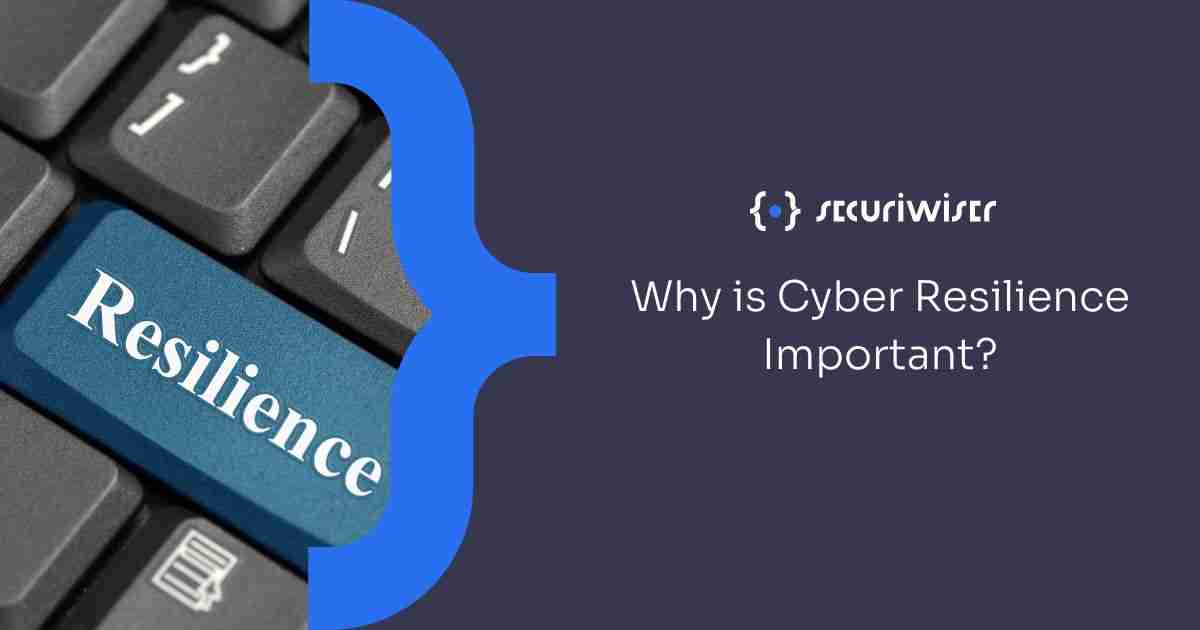Why is Cyber Resilience Important?
Blog / Why is Cyber Resilience Important?
5 MIN READ


In the context of schools in the UK, it is crucial to understand cyber resilience as the ability to prepare for, respond to, and recover from cyberattacks and data breaches while maintaining operational effectiveness.
An organisation can be considered cyber resilient when it can effectively defend against cyber threats, implement adequate cybersecurity risk management, and ensure business continuity during and after cyber incidents.
In recent years, cyber resilience and attack surface management have become essential components of cybersecurity due to the inadequacy of traditional security controls such as penetration testing and security questionnaires in minimising cyber risk.
The objective of cyber resilience in schools is to maintain your ability to ensure that the services remain uninterrupted at all times. This can include the ability to restore regular processes, as well as the ability to continuously change or modify protocols on an as-needed basis even after regular procedures have failed, such as during a crisis or after a security breach.
It is imperative for schools to prioritise cyber resilience to protect their students' and staff's sensitive information and ensure their continued education and operation
Why is Cyber Resilience Important?
In today's digital age, schools in the UK must recognise the importance of cyber resilience in protecting their students and staff from cyber threats. Schools store a wealth of sensitive information about their students, including personal data, academic records, and medical information.
Information held by schools can be highly valuable to cybercriminals, making schools an attractive target for cyberattacks. Therefore, schools must ensure that they have adequate cybersecurity measures in place to protect against these attacks and prevent data breaches.
Cyber resilience helps schools to maintain their ability to always its services. This means that they can restore regular processes and continuously modify protocols on an as-needed basis even after regular procedures have failed, such as during a crisis or after a security breach.
In today's cyber landscape, traditional security measures are no longer sufficient to guarantee information security, data security, and network security. Consequently, IT security teams should assume that unauthorised access to their organisation is inevitable.
Adverse cyber events, which can be caused by humans, nature, or a combination thereof, have a significant impact on the confidentiality, integrity, and availability of organisations daily. Therefore, the ability to respond to and recover from security breaches is just as critical as the ability to prevent them.
With effective cyber resilience, schools can avoid prolonged disruptions to their daily operations and ensure that students can continue to learn without interruption.
Successful Cyber Resilience Strategies
A successful cyber resilience strategy is comprised of four key elements, each critical for maintaining a secure network and information system:
- Manage and protect – this involves the ability to identify, assess, and manage cyber risks associated with network and information systems, including those of third-party and fourth-party vendors.
- Identify and detect - requires the use of continuous security monitoring and attack surface management to detect anomalies, potential data breaches, and data leaks before they cause significant damage.
- Respond and recover - involves implementing an adequate incident response plan to ensure business continuity, even in the event of a cyberattack.
- Govern and assure - ensures that the cyber resilience program is overseen from the top of the organisation and embedded into the standard business practices. These four elements are fundamental to a successful cyber resilience strategy that can help protect your organisation from cyber threats.
How Does Cyber Resilience Work?
For schools in the UK, any effective cyber resilience strategy needs to focus on preventive measures to counteract human error, vulnerabilities in software and hardware, and misconfiguration.
The ultimate goal of such a strategy is to protect the organisation while acknowledging that some parts may still be vulnerable despite robust security controls.
The key components of a successful cyber resilience strategy include:
Threat protection:
Cybercriminals continually advance, and their tactics evolve in lockstep with security controls. To improve cyber resiliency, schools should consider third-party risk management and attack surface management software.
These tools help schools minimise risks caused by misconfiguration, data leaks, and data breaches, and provide always up-to-date security ratings to help identify potential threats.
Recoverability:
After a security incident, schools must be able to resume regular operations quickly. This requires having infrastructure redundancies and data backups in different regions to ensure business continuity in the event of a natural disaster or cyberattack.
Running tabletop exercises is also recommended to ensure everyone knows their role during a cyberattack.
Adaptability
While planning is critical, adaptability is equally important. Schools must be able to evolve and adapt to new tactics developed by cyber criminals. Investing in continuous security monitoring can help school security teams recognize security issues in real-time and respond immediately.
Durability
A school's durability is its ability to operate effectively following a security breach. By implementing system improvements, configuration management, vulnerability management, and attack surface management, a school's cyber resilience can be improved and its ability to respond to and recover from security incidents can be enhanced.
What are the Benefits of Cyber Resilience?
Cyber resilience strategies offer a host of advantages to schools in the UK, not only during a cyberattack but also before and after:
Enhanced systems security can help improve IT governance, data protection, and safety and security of critical assets, while reducing the risk of human error and mitigating the impact of natural disasters.
Ultimately, implementing cyber resilience strategies can enhance the overall security of school systems.
Reduced financial loss is important to recognise as cyberattacks and misconfigurations can result in significant monetary loss. The average cost of a data breach globally can get into large figures, which can be devastating to small to medium-sized businesses.
Additionally, data breaches can have a negative impact on a school's reputation, especially with the introduction of stricter data protection laws and notification requirements.
Regulatory and legal compliance is essential for schools in the UK to ensure that they are meeting the legal requirements and standards set by government bodies and regulatory agencies.
Failure to comply with these regulations can result in significant financial penalties, loss of reputation, and even legal action.
Compliance also helps to ensure the safety and well-being of students and staff, and protects the school from potential legal liability.
Additionally, compliance can help to establish trust and credibility with stakeholders, such as parents, students, and regulatory bodies.
Enhancing work culture and internal processes in a school being cyber resilient requires collective efforts from all staff members to safeguard the organisation's sensitive data and ensure prompt incident response.
By empowering the employees to prioritise security measures, the school can significantly reduce the risk of exposure of sensitive data and physical assets.
How to Improve Cyber Resiliency
As a school, here are some techniques to improve resilience in dealing with cyber threats:
- Adaptive response: Enhance your ability to respond promptly and suitably.
- Analytic monitoring: Monitor and detect malicious actions and conditions in a timely and actionable manner.
- Coordinated protection: Implement a defence-in-depth strategy to add multiple obstacles for adversaries.
- Deception: Confuse, mislead, or hide critical assets from the adversary.
- Diversity: Use heterogeneity to minimise the impact of attacks exploiting common vulnerabilities.
- Dynamic positioning: Diversify your network to increase your ability to recover quickly from non-adversarial incidents.
- Dynamic representation: Keep your network representation current, understand dependencies, and identify adversary behaviour patterns.
- Non-persistence: Generate and retain resources as needed or for a limited time to reduce exposure to corruption, modification, or compromise.
- Privilege restriction: Limit user and system element privileges based on attributes and environmental factors.
- Realignment: Reduce the connections between critical and noncritical services to avoid the impact of noncritical service failures on mission-critical services.
- Redundancy: Provide multiple protected instances of critical resources.
- Segmentation: Define and separate elements based on criticality and trustworthiness.
- Substantiated integrity: Ascertain whether critical system elements have been corrupted.
- Unpredictability: Make random and unexpected changes to increase adversary uncertainty regarding system protections.
In conclusion, cyber resilience is an essential component of cybersecurity for schools to protect their students' and staff's sensitive information and ensure continued education and operation. Traditional security measures are no longer sufficient to guarantee information security, and schools must have effective cybersecurity measures in place to protect against cyber threats and prevent data breaches.
Successful cyber resilience strategies require managing and protecting cyber risks, identifying and detecting potential data breaches and data leaks, responding and recovering to cyber incidents, and governing and assuring the cyber resilience program. Investing in cyber resilience can enhance the overall security of school systems, reduce financial loss, and ensure regulatory and legal compliance.
As such, we encourage all schools to take the necessary steps to enhance their cyber resilience and protect their sensitive information, staff, and students from cyber threats.
Adopt a comprehensive cyber resilience strategy by signing up for a Securiwiser account today.
How secure is
your business?
Blog categories
How secure is
your business?